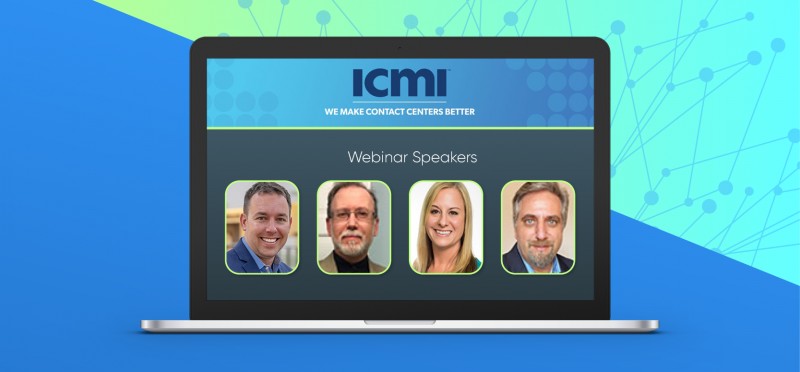Whether 2023 will usher in a mild recession or just an economic downturn, no one knows. What’s undeniable is whispers from that devil on your shoulder, “What about headcount?” are getting louder by the day.
Workforce reductions are tempting in the face of economic headwinds but technology and customer experience experts urge contact center leaders to take the long view, and resist. Technology investments will be more tempered in 2023 and that calls for more strategic planning, said panelists on the Nov. 30 ICMI webinar, “Weathering the Storm: Investing for Long-Term Contact Center Success."
“A lot of brands have a tendency toward what I call the ‘CX sacrifice,’ reducing staff and decreasing your time to serve. This is a mistake,” said panelist Nick Cerise, chief marketing officer at TTEC.
Instead, Cerise and analysts from global research firm Omdia mapped a path to keep the workforce intact, more productive, and better-equipped to deliver an exceptional customer experience.
Tech spending grows, though more slowly
More than half of global enterprises will increase contact center technology investments this year, said David Myron, principal analyst, contact center technologies, Omdia. Citing results from Omdia’s 2023 IT Enterprise Insights survey, Myron said 59% of companies plan strategic or minor cloud technology investments for the contact center in 2023, down from 63% this year.
Myron said other areas where contact centers will increase technology investment in 2023 include self-service automation and conversational AI/chatbots.
Another Omdia panelist, Mila D’Antonio, principal analyst, connected enterprise, said some companies view a potential economic slowdown as an opportunity to strengthen relationships with customers and invest in artificial intelligence (AI) that yields better business insights and automation.
Strategy, digital transformation
“Companies have to be more strategic in their planning and investments,” she said, “and the data is also telling about how vendors must position themselves on price and service going forward.”
While being more strategic about CX means seeking out savings, the panelists wondered how Frontier Airlines’ recent cost-cutting move to eliminate live telephone support will play out. The discount carrier now directs callers to its website, mobile app, social media, WhatsApp and chat.
“It will be interesting to see how this model works for them,” D’Antonio said. “If it does work, we will start to see more digital-only models take hold as more companies seek that holy grail of lowering costs while elevating the customer experience.”
TTEC’s Cerise said companies’ end goal should not be digital-first to the exclusion of all else. “The aspiration should be: Meet the customers where they are and deliver amazing service,” he said. “Optimize the way you are engaging customers but do it at lower total cost of ownership. That should be the aspiration to start with.”
Intelligent call routing, tools and process change
A chief problem contact centers face is that most customer intents are not intelligently routed, Cerise said. Companies can expect 10% to 20% cost savings just by routing customer inquiries to the correct channel, digital worker or live associate with the right skill set to resolve an issue, he said.
D’Antonio agreed managing channels is a challenge. More than half of North American CX professionals are unable to engage across channels in a relevant and personalized way, she said, citing Omdia’s State of Digital CX 2022 findings.
“We see the highest concentration in strategic and minor investments planned around things like intelligent virtual agents, video chat, and augmented reality,” D’Antonio added. “This points to the need for investing in the latest tools that reduce operating expenditures while elevating CX to meet customer expectations.”
Myron shared more 2023 IT Enterprise Insights findings that quantify spending plans in AI-powered solutions such as social listening/ticketing, digital customer contact analytics, and intelligent call routing.
Understand the why—and the what
Call centers need to examine reasons why customers engage in the first place. They also need to be realistic about what they’re asking associates to do.
“Understand your customer and why they are engaging. Then build a roadmap, a rapid roadmap, to try and solve for that,” Cerise said. That may mean routing a voice call to self-service, or keeping it in voice but deflect to messaging. It may mean routing to video so an associate can see what the customer sees to better troubleshoot a problem, such as crossed wires of a malfunctioning smart thermostat.
Examine your process, Cerise continued. For simple query like, “Where is my order?” associates may have to navigate 13 business applications, he said. “It sounds like I am making that up, but that’s an actual use case.” For this client, average handle time (AHT) of nine minutes was slashed to three minutes with robotic desktop automation TTEC deployed.
With streamlined processes and automation, companies can optimize responses and solve issues pre-emptively. All this leads to the ultimate goal, what Cerise calls “proactive CX.” By understanding customer intents, call centers can create incremental revenue with up-sell and cross-sell opportunities.
“Please don’t fall into that CX sacrifice trap,” Cerise advised. “Do not sacrifice your customer experience and make it horrible because you are just cutting heads.”
Attend the ICMI webinar, "Weathering the Storm: Investing for Long-Term Contact Center Success.”
Don’t succumb to the ‘CX sacrifice’















